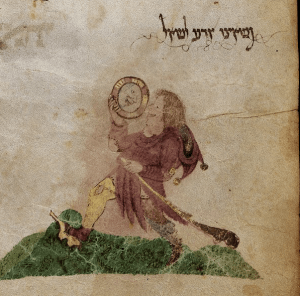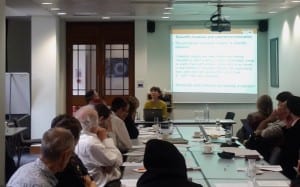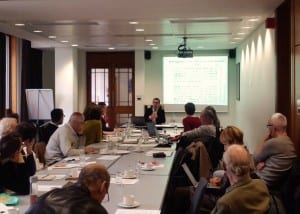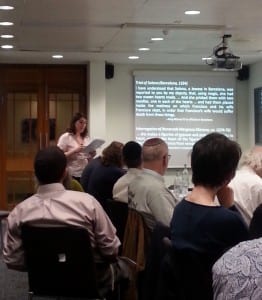Science versus popular culture in medieval Jewish society
By uclhvid, on 11 January 2016
On 9th November 2015 the ERC Calendars project team ran our 6th workshop, on the theme of ‘Science versus popular culture in medieval Jewish society’. Our aim was to explore the relationship between scholarly knowledge and popular lore in all areas of medieval Jewish culture, including Jewish law, calendar, alchemy, mathematics, medicine and magic. This theme is of particular relevance to the study of popular Jewish calendars – cyclical calendar schemes which are commonly found in the manuscripts but deviate from the official calendar described in scientific monographs.
The difficulty in studying the dichotomy between the elite traditions of knowledge and those of the common people lies in the first place in the scarcity of sources emanating from the more popular layers of society. Workshop participants suggested a number of ways in which information about the knowledge and traditions of common people can be extracted from literary sources. Apart from being explicitly attributed to the common folk, a practice can be identified as popular if it is presented in the sources without an attempt to provide a rationale for it, if it is not confined to people with specialised training, and if it is formulated in a relatively simple, rather than convoluted, metaphorical language.
In his talk “Jewish Law and Popular Custom in Medieval Ashkenaz” Ephraim Kanarfogel (New York) set out to assess the level of popular religious observance of Ashkenazi Jewry in the 12th-13th centuries by examining the rabbis’ response to customs that deviated from the Jewish Law. A talmudic principle “better a Jew err than transgress willfully” (Babylonian Talmud, Bezah 30a) determines that if common people follow an established custom that does not conform to the Jewish Law, it is better not to let the people know that they are sinning since the custom will unlikely be changed but people will follow it while knowingly transgressing. This dictum fully determined Sefardi rabbinic attitudes towards popular non-observance. In Ashkenaz, argues Kanarfogel, Tosafist rabbis rarely took recourse to “better a Jew err than transgress willfully”. Instead they endeavoured to account for deviant practices by looking for an earlier source of rabbinic authority, be it written or oral, that could underpin the popular custom. The different ways in which Sefardi and Ashkenazi authorities responded to popular customs highlight the Ashkenazi Tosafist rabbis’ conviction that the common folk in their community strive to follow the Jewish Law and do not transgress lightly. According to Kanarfogel this conviction must be grounded in the fact that in medieval Ashkenaz the gap between the elite and the popular layers was not so great and the community demonstrated a higher level of observance.
Sacha Stern (UCL) and Nadia Vidro (UCL) considered the knowledge of calendar among the common folk as well as calendar schemes allowing people with little calendrical knowledge to set the calendar. The Jewish calendar is based on scientific values and is set by calculation that requires levels of numeracy beyond what average people in the Middle Ages can be expected to have had. However, it was essential that people follow the calendar in order to fulfil religious commandments in their correct times. In his talk “Women and common folk in medieval Jewish calendar texts” Sacha Stern looked at how calendar was communicated to the masses at the time when not every home had a copy of the calendar. It appears that the synagogal ceremony of announcing the beginning of a New Month, which is still practiced today, was developed in early 12th century France and therefrom spread to other parts of the Jewish world. It is unclear whose responsibility it was to determine when the New Month was due to begin, or how calendar was communicated before the announcement was introduced. A number of sources on the calendar knowledge and calendar practices of women and the common folk testify that common people had a demand to obtain calendar information and had a relatively good grasp of the Jewish calendar apart from those elements of it the fixing of which required high levels of numeracy. Rules of thumb were used by the common folk to establish important calendrical dates, such as the day of the week of the Passover. Even though applying such rules does not always result in dates compatible with the standard calendar, these popular procedures appear to have been accepted without much critique, at least by 10th century authorities.
The main subject of Nadia Vidro’s talk “Scientific and popular calendars in medieval Jewish sources” was a calendar reckoning scheme that claims that the Jewish calendar forms a cycle of 247 years that can be fixed once and re-used forever, eliminating the need to calculate for those less numerically proficient. This calendar is incompatible with the standard Jewish calendar, which is by definition non-cyclical. Whereas the standard calendar reckoning procedure was detailed in a number of medieval scientific treatises based on the principles of Greco-Arabic astronomy, the reiterative calendar was never given any justification and was copied in non-technical manuscripts of liturgical and halakhic nature. This leads to the identification of this cycle as a popular calendar aimed at an audience unable to fix calendar by calculation. Notwithstanding its incompatibility with the standard calendar, the 247 year cycle became very widely distributed among Jewish communities in all geo-cultural areas. This is in stark opposition to the Rabbanite principle that the entire Jewish people should celebrate holidays and keep fasts at the same time. Notably, scientific calendar treatises refuted the reiterative calendar but could do little to stop the spread of the deviant popular cycle. Vidro suggested that in order to explain the popularity of the calendar cycle, which was known to scholars to be inaccurate, one had to look at the educational system through which calendar was taught and at the level of authority enjoyed by scientific works in the eyes of the less educated layers of population.
Talking about “Theory, Allegory and Practice in Medieval Alchemy: Jewish Sources and their Context” Gabriele Ferrario (Cambridge) noted that medieval alchemical treatises were composed in such convoluted, allegorical language that a high level of training was necessary to even understand the recipes. This, together with the fact that ingredients and instruments required for alchemical experiments were very costly, makes the existence of a popular alchemical tradition questionable. And yet non-alchemical sources stress that alchemy is a practice that simple people should not get involved in lest they lose all their possessions, testifying perhaps to the interest of non-professionals in alchemy for the purpose of making profit. Practical alchemical recipes discovered by Ferrario in the Cairo Genizah are suggestive of amateur Jewish alchemists: the recipes limit symbolic language to a minimum and are copied in crude handwriting with some vernacular Judaeo-Arabic spellings. Doctors and apothecaries, who in their work used materials and instruments similar to those necessary for alchemical permutations, may have been amateur alchemists and tried their hand at alchemical experiments.
In “Classical versus popular mathematics in medieval Hebrew mathematical and calendrical treatises” Ilana Wartenberg (UCL) looked at introductions of mathematical and astronomical works as sources of information on the general population’s scientific knowledge (or the lack thereof). Explaining their decision to compose a treatise some scholars did not just make a generic statement of the people’s ignorance but provided real live details of difficulties or misconceptions, such as the inability to correctly divide inheritance according to mathematical rules or a belief that the earth was flat. Another approach suggested by Wartenberg was to analyse the style of mathematical expositions in order to gauge the level of numeracy expected by authors of their readership. Thus, Ashkenazi writers expounding calendar reckoning chose to break down the calculation into minute steps characteristic of mental maths and to painstakingly write down every step, implying, perhaps, that they did not trust their readers to be able to carry out the calculation without such guidance.
Talking on “Medieval Jewish traditions on memorization in medical and magical texts” Gerrit Bos (Cologne) noted that in a society based on an oral legal tradition, memorising and retaining long texts was a matter of great legal and social significance. Consequently, an array of means for strengthening memory can be found in ancient and medieval Jewish texts. Rational means of memorisation included chanting and repetition and the use of mnemonics, including the Classical mnemonic of places. Memory was also strengthened by application of medicinal drugs, such as baladhur, the marking nut, and by consumption of foods that were believed to warm the brain by counterbalancing its cold and moist nature, for example, wheat, olive oil, wine and spices. These are found side by side with esoteric and magical means, such as mentioning magical names and reciting incantations that invoke the angel of forgetfulness, or using animal parts and stones as amulets for strengthening memory. These different means for preserving and strengthening memory were taken from various traditions and in the end it was practice and experience more than considerations of principle that determined which techniques were used. Even such rational thinkers as Moses Maimonides allowed for magical techniques on the grounds that in the future scholars might find a rational explanation why they are affective. In the ensuing discussion it was suggested that although remembering the oral traditions was important for all layers of society, bookish people may have had the greatest need to cultivate memory. Medical and esoteric means may have been elitist, whereas chanting and repetition would have been accessible to all.
Katelyn Mesler (Jerusalem) gave a talk entitled “Beyond the Trachtenberg Paradigm: New Approaches to Popular and Learned Traditions of Magic in Medieval Europe”. To Mesler, popular and elite knowledge can be distinguished along the axis of access. Specialised traditions of magic are limited to practicioners with specialised training: medical, astrological, philosophical. On the contrary, a common tradition of magic is defined by its accessibility to all segments of society, but not necessarily by the simplicity of the applied techniques. A magical practice should be viewed as part of a common tradition if it is often described in non-specialised literature, such as prayer-books, or can be found in a variety of contexts, for example, a spell worn as an amulet, written on food and then eaten, or written on a bowl from which water is to be drunk. Records of 14th and 15th-century Latin sorcery trials, which often involved Jews, show that professional Jewish magicians were accused of divination, whereas non-professionals were more often accused of using wax figurines, wearing amulets, or casting spells. Sources demonstrate that common and specialized medieval Jewish magical traditions were not incompatible: some specialised traditions conceptualised common practices, whereas elements of specialised magic filtered through to the popular tradition.
 Close
Close





